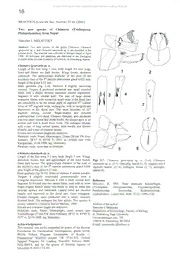
Two new species of Chimarra (Trichoptera: Philopotamidae) from Nepal PDF
Preview Two new species of Chimarra (Trichoptera: Philopotamidae) from Nepal
© Hans Malicky/Austria; download unter www.biologiezentrum.at 16 BRAUERIA (Lunz am See, Austria) 32:16 (2005) Two new species of Chimarra (Trichoptera: Philopotamidae) from Nepal Stanislav I. MELNITSKY Abstract Two new species of the genus Chimarra. Chimarra igvarvaria sp n and Chimarra nunenada sp. n. are described in the present study. The material was collected in Western Nepal in April 1998. All holotypes and paratypes are deposited in the Zoological Institute of the Russian Academy of Sciences, St-Petersburg, Russia Chimarra igvarvaria sp. n. Length of the fore wing 7 mm, body length 4.9 mm. Legs, head and thorax are dark brown. Wings brown, abdomen yellowish. The approximate diameter of the pore of the excretory duct of the 5lh sternite pheromone gland 0.022 mm, length of the gland 0.13 mm. Male genitalia (fig. 1-4): Sternum 8 slightly narrowing ventrad. Tergum 8 produced posteriad into small rounded lobes with a deeply divided narrowed middle impression. Segment 9 with ventral keel. The pair of large dorsal triangular blades with numerous small setae in the distal part are considered to be the dorsal parts of segment 9lh. Lateral lobes of 10th segment wide, rectangular, with an insignificant depression in the distal part. The inner branches of 10lh segment oblong, curved, finger-shaped and directed posterodorsad. Cerei short. Claspers elongate, apex produced into two small ventral and distal hooks; the clasper apex in its medial part with a small blunt hook. The aedeagus tubular, with a pair of long curved spines, wide basal ly and slender distally, and a pair of crescent spines. Female and immature stages are unknown. Holotype: male, Nepal, Dhawalagiri, Ghasa (24 km SW from Jomson), 28°37' N, 83°38' E, 2013 m, streams near river Kaligandaki, 16.04.1998; leg. Melnitsky. Paratype: male, same data as holotype. Chimarra nunenada sp. n. Length of the fore wing 5.1 mm, body length 3 mm. Wings, abdomen, thorax, legs and appendages of the head brown. Figs 1-7: Chimarra igvarvaria sp. n. (1-4), Chimarra Head dark brown. The approximate diameter of the pore of nunenada sp. n. (5-7). Genitalia, lateral (1, 5), claspers and 9 the excretory duct of the 5th sternite pheromone gland 0.029 segment ventral, (2, 6), aedeagus, dorsal (3, 7), aedeagus, mm, length of the gland 0.17 mm. lateral (4). Male genitalia (fig. 8-10): Sides of sternum 8 almost parallel. Tergum 8 slightly sclerotized posteromesally with a triangular depression. Sternum 9 with a small ventral keel. Reference Segment 10 divided into two lateral lobes, each with an inner MALICKY, H. 1993: Neue asiatische Köcherfligen finger-shaped branch about two-thirds as long as lobes and (Trichoptera: Philopotamidae, Polycentropodidae, directed upward and backward. Lateral lobes are rounded Psychomyidae, Ecnomidae, Hydropsychidae, basally and narrowed in the distal part. Cerei triangular. Leptoceridae) - Linzer biol. Beitr. 25 (2): 1099-1136. Clasper elongate, apex produced into a small, ventrally directed hook. The aedeagus has four spines. This species is closely related to Chimarra hezron Malicky, 1993. Address of the author: Female and immature stages are unknown. Stanislav I. Melnitsky Holotype: male, Nepal, Dhawalagiri, small stream near Department of Entomology, Faculty of Biology Tirkhedhunga (27 km NW from Pokhara), 28°23' N, 83°45' E, St. Petersburg State University 1577 m, 20.04.1998; leg. Melnitsky. Universitetskaya nab., 7/9 199034 St. Petersburg, RUSSIA Acknowledgements E-mail: [email protected] This research was partly supported by grants of the Russian Foundation for Fundamental Investigations, grants 02-04- 49138, Federal Program Universities of Russia — Fundamental Sciences project UR 07.01.032, Federal Support Program for Leading Scientific Schools NSH- 2232.2003.4, and by the grants of Russian Agency of Education JV2AO4-2.12-161.
